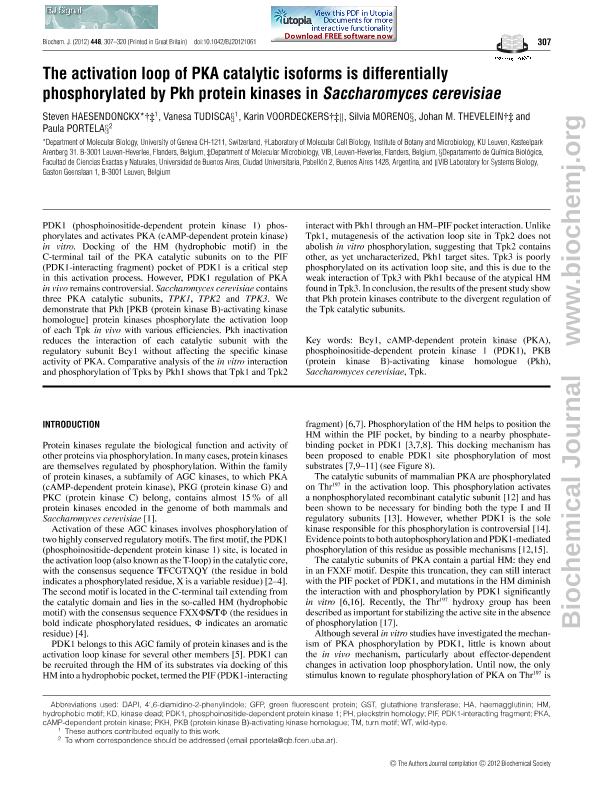Mostrar el registro sencillo del ítem
dc.contributor.author
Haesendonckx, Steven
dc.contributor.author
Tudisca, Vanesa Romina

dc.contributor.author
Voordeckers, Karin
dc.contributor.author
Moreno, Silvia Margarita

dc.contributor.author
Thevelein, Johan M.
dc.contributor.author
Portela, Paula

dc.date.available
2018-12-20T15:28:40Z
dc.date.issued
2012-09
dc.identifier.citation
Haesendonckx, Steven; Tudisca, Vanesa Romina; Voordeckers, Karin; Moreno, Silvia Margarita; Thevelein, Johan M.; et al.; The activation loop of PKA catalytic isoforms is differentially phosphorylated by Pkh protein kinases in Saccharomyces cerevisiae; Portland Press; Biochemical Journal; 448; 3; 9-2012; 307-320
dc.identifier.issn
0264-6021
dc.identifier.uri
http://hdl.handle.net/11336/66822
dc.description.abstract
PDK1 (phosphoinositide-dependent protein kinase 1) phosphorylates and activates PKA (cAMP-dependent protein kinase) in vitro. Docking of the HM (hydrophobic motif) in the C-terminal tail of the PKA catalytic subunits on to the PIF (PDK1-interacting fragment) pocket of PDK1 is a critical step in this activation process. However, PDK1 regulation of PKA in vivo remains controversial. Saccharomyces cerevisiae contains three PKA catalytic subunits, TPK1, TPK2 and TPK3. We demonstrate that Pkh [PKB (protein kinase B)-activating kinase homologue] protein kinases phosphorylate the activation loop of each Tpk in vivo with various efficiencies. Pkh inactivation reduces the interaction of each catalytic subunit with the regulatory subunit Bcy1 without affecting the specific kinase activity of PKA. Comparative analysis of the in vitro interaction and phosphorylation of Tpks by Pkh1 shows that Tpk1 and Tpk2 interact with Pkh1 through an HM-PIF pocket interaction. Unlike Tpk1, mutagenesis of the activation loop site in Tpk2 does not abolish in vitro phosphorylation, suggesting that Tpk2 contains other, as yet uncharacterized, Pkh1 target sites. Tpk3 is poorly phosphorylated on its activation loop site, and this is due to the weak interaction of Tpk3 with Pkh1 because of the atypical HM found in Tpk3. In conclusion, the results of the present study show that Pkh protein kinases contribute to the divergent regulation of the Tpk catalytic subunits. © The Authors Journal compilation © 2012 Biochemical Society.
dc.format
application/pdf
dc.language.iso
eng
dc.publisher
Portland Press

dc.rights
info:eu-repo/semantics/openAccess
dc.rights.uri
https://creativecommons.org/licenses/by-nc-sa/2.5/ar/
dc.subject
Bcy1
dc.subject
Camp-Dependent Protein Kinase (Pka)
dc.subject
Phosphoinositide-Dependent Protein Kinase 1 (Pdk1)
dc.subject
Pkb (Protein Kinase B)-Activating Kinase Homologue (Pkh)
dc.subject
Saccharomyces Cerevisiae
dc.subject
Tpk
dc.subject.classification
Otras Ciencias Biológicas

dc.subject.classification
Ciencias Biológicas

dc.subject.classification
CIENCIAS NATURALES Y EXACTAS

dc.title
The activation loop of PKA catalytic isoforms is differentially phosphorylated by Pkh protein kinases in Saccharomyces cerevisiae
dc.type
info:eu-repo/semantics/article
dc.type
info:ar-repo/semantics/artículo
dc.type
info:eu-repo/semantics/publishedVersion
dc.date.updated
2018-09-24T14:13:20Z
dc.journal.volume
448
dc.journal.number
3
dc.journal.pagination
307-320
dc.journal.pais
Reino Unido

dc.journal.ciudad
Londres
dc.description.fil
Fil: Haesendonckx, Steven. Universidad de Ginebra; Suiza. Katholikie Universiteit Leuven; Bélgica. Flanders Interuniversity Institute For Biotechnology; Bélgica
dc.description.fil
Fil: Tudisca, Vanesa Romina. Consejo Nacional de Investigaciones Científicas y Técnicas; Argentina. Universidad de Buenos Aires. Facultad de Ciencias Exactas y Naturales. Departamento de Química Biológica; Argentina
dc.description.fil
Fil: Voordeckers, Karin. Flanders Interuniversity Institute For Biotechnology; Bélgica. Katholikie Universiteit Leuven; Bélgica
dc.description.fil
Fil: Moreno, Silvia Margarita. Consejo Nacional de Investigaciones Científicas y Técnicas; Argentina. Universidad de Buenos Aires. Facultad de Ciencias Exactas y Naturales. Departamento de Química Biológica; Argentina
dc.description.fil
Fil: Thevelein, Johan M.. Flanders Interuniversity Institute For Biotechnology; Bélgica. Katholikie Universiteit Leuven; Bélgica
dc.description.fil
Fil: Portela, Paula. Consejo Nacional de Investigaciones Científicas y Técnicas; Argentina. Universidad de Buenos Aires. Facultad de Ciencias Exactas y Naturales. Departamento de Química Biológica; Argentina
dc.journal.title
Biochemical Journal

dc.relation.alternativeid
info:eu-repo/semantics/altIdentifier/doi/https://dx.doi.org/10.1042/BJ20121061
dc.relation.alternativeid
info:eu-repo/semantics/altIdentifier/url/http://www.biochemj.org/content/448/3/307
Archivos asociados
